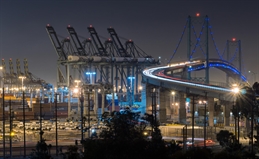
As the severe congestion at the port complex of Los Angeles and Long Beach shows no sign of abating, there are indications that some operators are looking for alternatives.
The premier US gateway for ocean cargo has been struggling with soaring import volumes for months, and congestion has spread from the docks in all directions, resulting in radically longer turn times for truckers as well as longer wait times for ships to berth.
The Port of Los Angeles is launching an incentive program for terminals to speed up truck turn times, but this may be thwarted by a rise of Covid-19 infections among dockworkers.
Volumes have been rising in Los Angeles and Long Beach since June, driven by restocking efforts of retailers and the rapid growth of e-commerce. This crescendo saw US imports climb to US$212 billion in November, up 2.6% year on year, while exports advanced 0.8%.
The following month produced a new record in imports from Asia, with the overall volume in terms of TEUs up 29.9% from December 2019. As retailers and e-commerce merchants were rushing to bring in goods before the Christmas holiday, more shipments from Asia were routed on the faster route to the West Coast rather than to ports on the Eastern Seaboard or in the Gulf of Mexico.
The rising influx of traffic after the slump between March and June resulted in record annual throughput figures for Los Angeles and Long Beach. The former handled 9.2 million TEUs last year, while Long Beach clocked up 8.1 million TEUs.
According to supply chain risk consultants Resilience 360, both ports have been operating at maximum capacity.
In conjunction with reduced work crews on the docks as a result of measures to prevent the spread of Covid-19, the elevated volumes led to congestion on the docks. With yard utilization at container terminals north of 80%, boxes piled up at the ports and had to be stacked five high, as opposed to three high. This, in turn, slowed down the retrieval of containers to hand over to truckers, stretching waiting times for them.
As a result, truck turn times at the container terminals stretched to 93 minutes on average in December, a far cry from the 58-minute average recorded in June, when imports from China were at a low.
The slower pace of operations on the docks also contributed to a pile-up of ships waiting to discharge their loads. This was accelerated by a high number of sailings to meet the demand for US-bound capacity after the blanked sailings earlier in the year. On most days on December 28-30, vessels were waiting for space to berth at the port complex, and waiting periods of seven days were common.
Drewry Maritime Advisors warned already in early December that the gridlock at terminals was becoming critical.
The end of the peak season brought no relief. Volumes pouring into Los Angeles and Long Beach have remained at high levels. Two weeks into January operators were reporting that the entire supply chain around the ports had been overwhelmed, stretched to capacity, and several predicted that the congestion would not ease up before March.
To alleviate the congestion on the land side the port of Los Angeles announced an incentive scheme for container terminal operators to shorten truck turn times. Starting on February 1, terminals that can cut those between 5% and 20% will be paid between 50 cents and $2.75 per container by the port authority. If one manages to keep average turn times down to 35 minutes or below in a given month, it will receive $3 per container.
In a flanking measure, the port authority pays between 40 cents and $1.40 per loaded TEU to terminals where at least half the trucks drop off one container and haul off another in a single visit. About 75% of the containers moving through the port are hauled by drayage firms.
Drayage operators have welcomed the measure. However, there has been rising concern over Covid-19 infection rates among port workers. According to the International Longshore and Warehouse Union, more than 600 infections have been counted at the port complex between the beginning of December and January 15. The union has called on governments to assign longshoremen essential worker status to give them priority for Covid-19 vaccination. The Pacific Maritime Association, which represents the employers, has expressed concern about the development but stated that this would not cripple handling operations at the ports.
Some players appear to be losing faith in the California gateways. According to one report, CMA CGM is stopping its premium trans-Pacific service to Los Angeles, one of the faster offerings between Asia and the West Coast. It comes with a money-back guarantee if containers are not ready for pick-up by a set date. With the delays at Los Angeles, the shipping line apparently decided that this was no longer viable. It is reportedly planning a new route from China to Seattle and Oakland.
By Ian Putzger
Correspondent | Toronto



